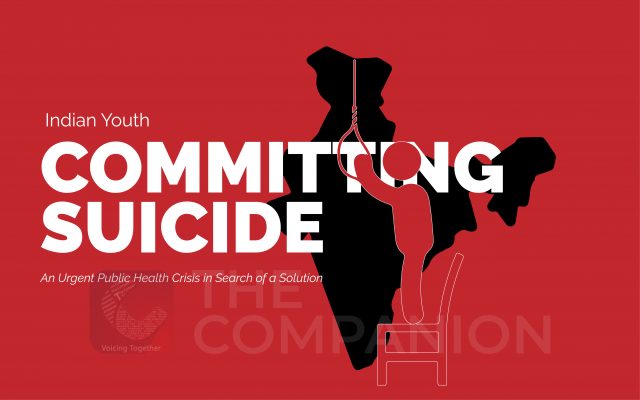Introduction
In yet another tragic incident that highlights the horrific epidemic of student mental health crisis in Kota, a city known for its unrelenting coaching culture, a student from Uttar Pradesh took his own life on 27th of September while preparing for the NEET exam. This tragic incident is the 26th suicide case to be reported in Kota this year alone, highlighting the frightening and continuing toll on young aspirants’ lives. These brilliant young minds continue to be driven to the breaking point by the same unyielding forces: crushing study pressure and a crippling dread of failure.
This death was more than just a statistic; it was a manifestation of the profound rot that permeates our country’s institutions, in this case, a coaching centre. Keeping in mind the circumstances at the institute and academic pressures on children, a catastrophe like this was inevitable. It acts as an urgent warning that we are facing an imminent threat that has to be addressed right away.
Cases of suicide are of a very different nature in the developing world, of which India is a part. The research on suicide is rich, but it is quite individualistic and neglects the socio-economic context in which it occurs. This is evident by the measures adopted by administrations to address the suicide epidemic. Last month, district administration in Kota installed spring-loaded fans in every room to provide students mental support and security, which, some may say, is a ludicrous solution to address the issue. These ceiling fans have springs that are built to uncoil the second they sense a load, essentially separating the fan off the ceiling and preventing hangings. It is essentially a band-aid fix that touches the symptom of a problem with deep roots.
The many different factors that contribute to suicide are well known, and they integrate in intricate patterns. But most research on suicide risk factors has been done in wealthy nations, and little has been accomplished to methodically analyse vulnerability variables in less developed nations. Moreover, self-injury among younger individuals is prevalent, and suicide is one of the main causes of death among youth. Poor psychological well-being is strongly correlated with numerous additional problems affecting the youth’s overall well-being, including academic performance, abuse of substances, aggression and sexual health.
Prevalence in India
In India, one organisation that gathers data on suicides is the National Crime Records Bureau (NCRB) from police-recorded instances of suicide. In the country, as per its latest data, 1,64,033 suicides were recorded in total in 2021.
Several important studies have identified various age/sex groups as having a higher risk of suicide in developed countries. However, the sociodemographic risk factors are quite unique in the developing world and specifically in India. According to NCRB, the overall male to female suicide victim ratio for 2021 was 72.5: 27.4. Marriage-related problems, more specifically dowry-related problems, and impotence/infertility, are the two factors that lead to suicide in young women most frequently. Furthermore, youth (defined as people aged 18-30) were the most vulnerable group. Youth suicide rates account for 35–40% of all the suicide cases in India. Youth suicidality differs from adult suicide in that it is more prevalent, impulsive, linked with higher levels of externalising behaviours (such as drug abuse and aggression), greatly impacted by friends and media coverage (copycat suicide), linked to life stresses (such as family, a relationship, as well as academic problems), and more reliant on the accessibility of ways to commit suicide.
The risk factors of suicide among young people
Gender: In developing countries like India, the suicide rate among young women is higher than it is in developed nations. This may be because women are more likely to experience mood disorders and other internalising problems than men, because there are more psychosocial stressors (such as cross-generational disputes in a farming society) and because of cultural customs that violate women’s rights, such as intimate partner violence and the practise of self-destruction (following the death of one’s husband, or “Satipratha”) in some Indian subcontinental cultures. Additionally, compared to men, women are stigmatised more for having mental illnesses. Women are also more likely to suffer from anxiety and depression.
A large body of research suggests that the presence of mental illnesses like depression, problems with adjustment, schizophrenia, bipolar affective disorders, ADHD, and the consumption of alcohol are linked to an increased risk of suicide among young people. Contrary to what has been discovered in the western world, the availability of alcohol in India (and restrictions on its consumption) have not been proven to lower the incidence of suicide. Academic stressors are significant. In low-middle income households, youth are under immense pressure to perform well and bring their family out of poverty. Failures in academics create feelings of immense guilt, hopelessness and worthlessness in children who begin to feel like a burden. This, coupled with physical abuse in families exacerbates shame and suicidal thinking.
A dearth of positive emotions, with the strongest evidence being for anhedonia, is additionally linked with persistent suicide behaviours.
Inability to recognise emotions and lack of access to good coping mechanisms, the former more so than the latter, predicts future suicide attempts amongst youth. In a culture where people are strongly discouraged from expressing negative emotions, this may result in a host of emotional management issues.
Additionally, unhealthy cognitive strategies for controlling emotions including ruminations and suppression have been linked to teenage suicide, whereas redirection and problem-solving abilities are preventative.
Suicidal behaviour is also predicted by how adaptable different emotional regulation mechanisms are.
Selective information processing and associated biases are indicators of teenage suicidality.
It includes biases in attention and memory, the latter of which causes abnormalities in autobiographical memory in those who attempt suicide who remember past events in a more generalised fashion than their counterparts who are not attempting suicide.
Loneliness is a direct predictor of death by suicide in young people. Stifled feelings of belongingness among females and a sense of burdensomeness among men are predictors of juvenile suicide attempts. Additionally, social communication and reaction processing are important for interpersonal interactions and are linked to teenage suicidality. People with better social skills generally are at a lower risk for suicide. Low self esteem has been associated with suicide, on the other hand.
Any type of child abuse—physical, sexual, or emotional—counts as maltreatment in children, with sexual abuse having the strongest and most conclusive proof of links with suicide. Suicidality and emotional maltreatment have been linked, especially in older children and teenagers. Bullying, or peer victimisation, in any form (e.g., social exclusion, verbal or physical abuse, peer pressure, etc.), is linked to suicidal behaviour in children and adolescents. It encompasses purposefully damaging or upsetting behaviour that escalates power imbalances and is repeated.
Those who attempt suicide are more likely to originate from a dysfunctional family.
Similarly, parental loss (due to premature death or parental divorce) is associated
with youth suicide, independent of the depressive symptoms following such loss. One’s social support system plays a major role in providing resilience to people. An absence of strong support from family and peers results in a diminished ability to cope with everyday stressors.
There have been reports of a greater suicide rate among indigenous people worldwide. Increased alienation may result from rapid cultural change, assimilation, and the loss of customary cultural practises. For instance, Gujarat in India has found a higher suicide rate among religious minorities. India’s youth experience suicidal behaviour as a result of prejudice based on caste, inter-caste rivalry, and related educational and professional disadvantages. Many such cases of suicide are reported in higher educational institutions of the country, where discrimination along the lines of caste and religion are prevalent.
The substantial number of suicides in India may be caused in part by religious beliefs and practises. For example, deeply held religious beliefs about rebirth (which do not view death as the final step) have been linked to acts of self-sacrifice, including suicidality. On the other hand, religious beliefs that condemn suicide protect some from suicide.
Another significant determinant of youth suicide is the perceived stigma associated with both suicidal behaviour and psychological conditions in wider society, coupled with its medical and legal ramifications. Although a law decriminalising suicide recently went into effect in India, it is still unclear, and its execution is still subpar. This causes suicide behaviours to go unreported and therapy to be delayed, especially in young females.
Strategies for prevention
From the perspective of India, it is also crucial that suicide prevention strategies concentrate on fostering the overall wellness of populations: economic policies aiming at social justice, programmes to meet basic human needs, developing resilience, and setting up support systems.
Youth suicidality has been proven to be decreased by school-wide screening and education programmes regarding the risks of suicide and the symptoms and indicators of depression.
Selective prevention tactics try to stop the emergence of prevalent risk factors for mental illness and suicide in young people by focusing on vulnerable populations (those who have experienced trauma or abuse, etc.). There is preliminary evidence for family-based risk prevention and resilience programmes that emphasise problem-solving, emotional control, and enhancing peer support while simultaneously preventing the development of unhealthy coping mechanisms like substance use, externalising behaviours, etc.
Recent research has revealed that young people’s online cognitive and affective tendencies can predict their risk of suicide. Young people who are susceptible frequently engage in implicit behaviour that is associated to dying, suicide, or self-harm. Youth suicidal conduct has decreased as a result of the preparatory interventions using evaluative conditioning techniques to create a distaste for suicide, self-harm, and death. Parents, peers and teachers should be vigilant and look out for warning signs like disturbed sleep, poor appetite, fatigue and isolation, aggressiveness, substance abuse and impulsivity among other things.
Drug treatments for depression and impulsivity bring down risk for suicide by preventing risk for depression and other risk factors for suicide. Other popular treatments like cognitive behavioral therapy and mindfulness training have been shown to reduce risk for suicidal ideation and suicidal behaviours.
How media covers issues like suicide can make a massive difference. The promotion of mental health, raising awareness of suicide, and disseminating accurate information regarding suicide can all be greatly aided by the media.
Suicide is still stigmatised and seen as a crime by the majority of Indians, which makes it difficult for young people (and their families) to disclose their suicide thoughts and causes them to put off getting help. Measures should be done to ensure that it is effectively disseminated and implemented as this will encourage a sympathetic and encouraging attitude in society towards the kids who engage in suicidal behaviours.
In conclusion, although suicide is a widely studied problem, India and other developing nations need to explore this issue more, tackle the stigma surrounding the topic, understand the cultural factors that influence juvenile suicide and the development of therapies that are appropriate for their culture. This should be done keeping in mind the unique concerns of the youth of the country, and treatments that cater to their unique needs. In order to combat the excessive stress that educational institutions place on students, substantial adjustments are required. It is an urgent appeal to action since our youth deserve better.
About the author:
Umrah Beg is a psychology student and writer passionate about illuminating the intersection of mental health and socioeconomic challenges among youth. Through her explorations at the nexus of politics and psychology, she delves into the macrosystemic complexities faced by diverse communities. My writings and research aim to foster awareness and advocate for more equitable support systems and shed light on well-known psychological concerns from a lens that acknowledges diversity of socio-political realities.







Very interesting and informative!